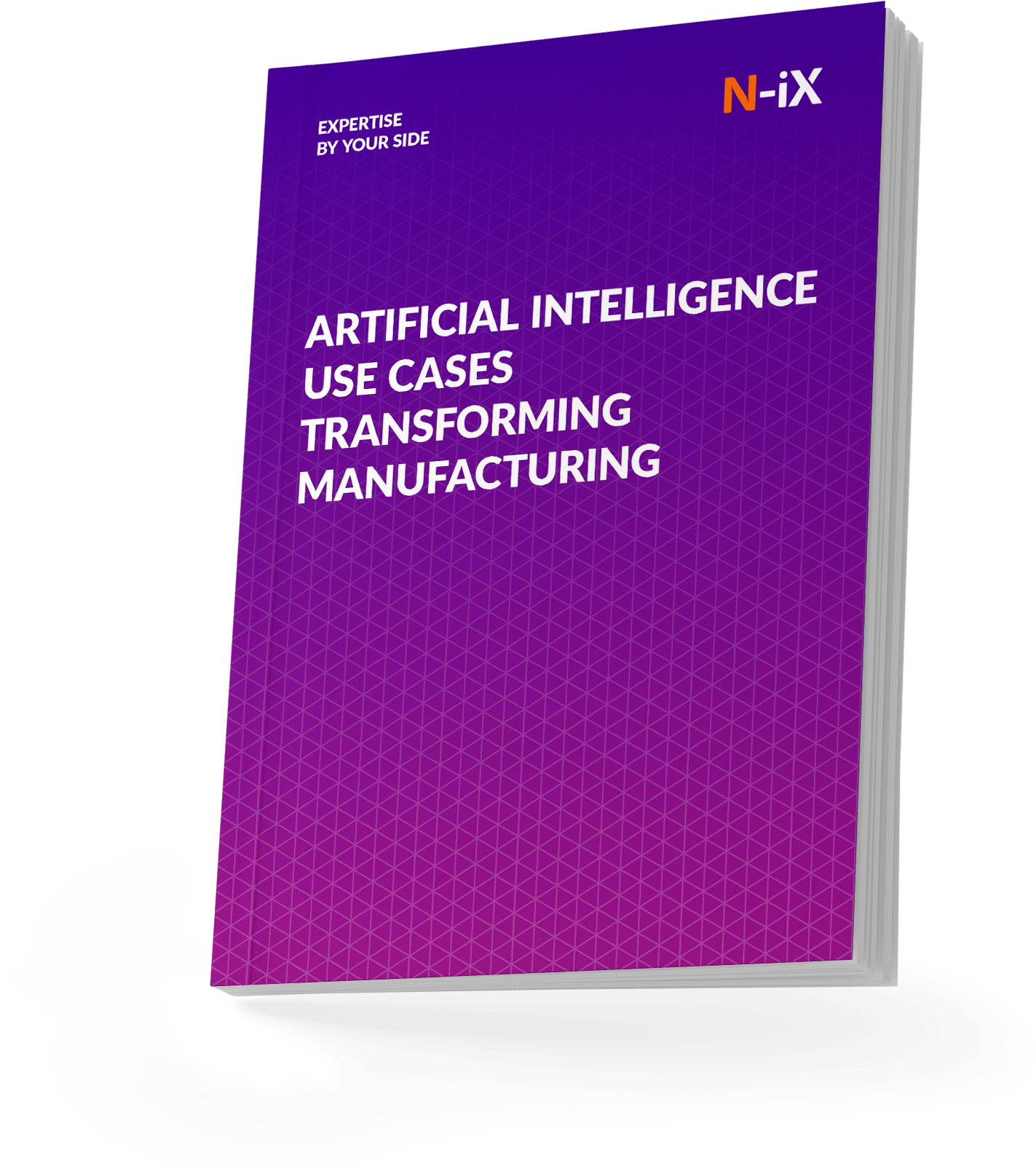Manufacturers face a critical challenge: achieving profitable growth while maintaining the highest quality standards. Many are leveraging technology to bridge this gap, implementing solutions like production monitoring and quality management systems. According to the PLEX study, a substantial portion of operating budgets (23%) are already dedicated to technology, highlighting the growing recognition of manufacturing software development services that can optimize processes, improve efficiency, and enhance quality control.
However, Userlane research indicates that 91% of digital transformation projects fail due to poor planning, resistance to change, or integration challenges. These roadblocks translate into wasted time and resources, employees losing valuable hours due to software issues, and companies incurring substantial costs from failed projects.
Crafting a manufacturing digital transformation roadmap
To take full advantage of Industry 4.0, manufacturers need a company-wide digital transformation roadmap for manufacturing encompassing productivity, sustainability, and a competitive edge. Many manufacturers are already seeing success with individual smart technologies like AI, ML, IoT, and automation. A recent MPI Group study of 445 manufacturers around the globe shows 63% reporting increased profitability and 61% a competitive advantage resulting from these technologies. However, a holistic approach can unlock even greater potential. Here are the initial steps to take when developing a digital transformation roadmap for manufacturing:
- Start with a vision: Develop a long-term strategy that aligns with your business goals. Consider how digital transformation can help you achieve profitability, competitiveness, and sustainability objectives. Avoid getting stuck in pilot purgatory - move efficiently from planning to implementation. Consider partnering with a strategic advisor to guide your journey.
- Focus on business objectives: Identify the business problems you're trying to solve with digital transformation. This could involve improving the speed of delivery, product personalization, or sustainability. Build a business case to secure budget resources by demonstrating the return on investment (ROI) potential. Focus on leadership buy-in and highlight key metrics like cost reductions and efficiency gains.
- Choose the right technology provider: Don't just focus on technology adoption for its own sake. Identify solutions that address specific business problems and deliver actionable insights to improve outcomes. Partner with technology providers who understand your needs and can demonstrate the value proposition of their solutions.
- Work within a partner network: Choose a partner network that offers holistic visibility across your organization. This allows you to connect core business operations with manufacturing for a more agile and responsive approach. Find partners with a history of helping companies achieve their digital transformation goals.
While the roadmap we've outlined provides a clear direction, each company's path to digital transformation has its detours. Even the most meticulously crafted plans can encounter unforeseen obstacles. We'll explore some of the key challenges manufacturers may face during digital transformation.
Challenges faced by modern manufacturers
Maintaining quality and profitability
For manufacturers, the constant struggle is balancing the bottom line with a commitment to quality. Many increasingly rely on technology to address production issues and achieve this critical balance. This highlights the growing need for a digital transformation roadmap for manufacturing.
Among those who have already embraced smart manufacturing elements, production monitoring (54%) and quality management systems (QMS) (51%) are the most popular solutions. Only 10% of respondents have no plans to adopt a QMS, highlighting the widespread recognition of its importance. This data indicates a growing demand for various technological solutions.

Staying sustainable
In the past, fostering collaboration and tackling social issues were manufacturers' primary motivations for pursuing sustainability and ESG (Environmental, Social, and Governance) initiatives. However, there's been a notable shift in priorities over the last year. Improving operational efficiencies has emerged as the top reason for embracing sustainability, indicating a growing recognition of its positive impact on the bottom line, alongside its established social benefits.

Strengthening cybersecurity
Manufacturing took a hit in 2022, with the highest average ransom payments from cyberattacks at a staggering $2M. Cyberattacks pose a constant threat, with the potential to cripple supply chains, endanger worker safety, damage reputations, and inflict severe financial losses. Respondents of the State of Manufacturing Report recognized this critical challenge and ranked cybersecurity risks as the primary obstacle that smart manufacturing initiatives can help mitigate.

Investing in the right tools and technology
According to the State of Manufacturing Report, manufacturers dedicate an average of 23% of their operating budgets to technology, with significant variation across industries. Regardless of the investment level, however, companies must keep a future-oriented perspective when allocating these funds.
To address the growing skills gap, businesses should invest in technologies that bridge that gap, including automation, ML, and AI. These investments will enable the full potential of data-driven insights across the organization.
Highly regulated sectors, such as aerospace, allocate nearly double the budget (34%) compared to packaging (18%) and metals sectors (18%). However, it's important to consider that some lower-investment industries face tight margins and prioritize cost reduction. Digital transformation in manufacturing initiatives can be crucial in optimizing processes and achieving efficiency gains despite budget constraints.

Manufacturers today face a double-edged sword: a vast array of powerful new technologies. This abundance, however, can lead to a phenomenon known as "technology paralysis"—the inability to choose the right solution due to overwhelming options. Organizations that face this struggle may fall behind competitors in the race for technological innovation.
The urgency of this challenge is underscored by a staggering 65% year-on-year increase in the number of respondents who believe their current technology stack is insufficient to maintain a competitive edge over the next twelve months.

Manufacturers are increasingly turning to technology to combat these challenges. Notably, 53% of respondents indicated that adopting new technologies is their primary strategy for minimizing disruptions caused by workforce or supply chain issues. Additionally, 50% leverage cloud migration to enhance cybersecurity protection and ensure business continuity.
Furthermore, technology adoption remains the leading approach (44%) for mitigating external risks such as inflation, supply chain disruptions, and workforce shortages. These findings point to the growing importance of technology as a risk management tool within the manufacturing sector. Let's explore these technological solutions in more detail.
Read more: 2023 guide to digitization in manufacturing in 5 essential steps
Tech-enabled solutions for resilience and growth
A clear trend is emerging in manufacturing: a focus on tech-enabled resilience. Companies strategically invest in cloud, smart manufacturing, and other technologies to create a future-proof operation and gain a competitive advantage.
Smart manufacturing
Manufacturers are recognizing the significant benefits this technology offers, including:
- Enhanced efficiency and productivity;
- Improved return on investment (ROI);
- Optimized workforce management;
- Increased sustainability.
This realization of its potential is evident in the digital transformation plans. Nearly half (45%) plan to integrate the technology within the next year, with an additional 39% targeting adoption within the following 1-2 years. Implementing smart manufacturing is one of the key cornerstones of a successful digital transformation roadmap for manufacturing.
Manufacturers are reaping significant rewards from their technology investments. Among those who adopted new technologies last year, 33% identified process automation as delivering the highest return on investment (ROI). Interestingly, the most popular technology investments—process automation and cloud/SaaS solutions (adopted by 63% of participants)—are also the most financially beneficial. Following process automation in terms of ROI are cloud/SaaS solutions and the Industrial Internet of Things (IIoT) deployments.

Investing in cloud-based solutions to enhance security and cost-effectiveness
The cloud continues its ascent as a critical tool for manufacturers. Manufacturers are flocking to cloud-based solutions because of their advantages in adaptability, security, rapid deployment, cost-effectiveness, and overall ROI. This trend is expected to continue, with nearly half (44%) of respondents planning to ramp up investments in cloud technology, applications, or infrastructure within the next year. This surge underscores the cloud's growing role in the manufacturing landscape.

Leveraging AI for better quality control and forecasting
A resounding message emerged from the State of Manufacturing survey of 1,353 global manufacturers: 45% identified improving quality as a primary driver for accelerating digital transformation within their organizations. This focus on quality is shaping the future of digitalization in manufacturing.
With today's disrupted supply chains and evolving regulations, manufacturers prioritize agility and maintaining top-quality products. Digital transformation is key to navigating these challenges and achieving sustained growth. This prioritization of quality underscores manufacturers' commitment to excellence, even amidst disruption.

WHITE PAPER
Transform your manufacturing processes with AI: Discover key use cases in the white paper!


Success!

Transform your manufacturing processes with AI: Discover key use cases in the white paper!


Success!

Implementing ESG initiatives to reduce waste
Product quality and safety are paramount for manufacturers in ESG (Environmental, Social, and Governance) and sustainability initiatives. Minimizing manufacturing waste and recycling follow closely behind as important priorities.
This focus on responsible practices aligns with the growing interest in the "circular economy." This approach emphasizes eliminating waste and pollution by designing products and processes for optimal efficiency and extended lifespans. Repair and reusability are key principles within the circular economy model. A digital transformation roadmap for manufacturing can play a crucial role in implementing these sustainable practices.
Further substantiating this trend, a recent Gartner survey found that 74% of supply chain leaders anticipate profit growth by 2025 through implementing circular economy principles. On average, supply chain organizations have already incorporated these principles for three years, with roughly 16% of their product portfolios designed with circularity in mind.

Using data to improve performance and profitability
The State of Manufacturing Report reveals that one-third of data generated by manufacturers goes untapped. 40% more manufacturers in 2023 than last year report an inability to leverage data effectively for competitive advantage. This underutilization occurs despite a growing recognition within the industry that increased technology adoption creates vast amounts of valuable data. This data has the potential to be harnessed and analyzed to significantly improve performance and profitability. Data and analytics usage are critical areas for improving positive business outcomes over the next five years.

Wrap-up
Manufacturing is undergoing a significant transformation. While the challenges are real—from maintaining quality and profitability to navigating supply chain disruptions and cybersecurity threats—the opportunities are even greater. Businesses that adopt a digital transformation roadmap for manufacturing can achieve increased efficiency, resilience, and competitive advantage. By taking a proactive approach to digital transformation, manufacturers can manage the complexities of the modern marketplace and emerge as leaders in Industry 4.0.
Have a question?
Speak to an expert




